BuySellBA
Administrator
Multicolored houses and facades that look like Caminito: where the southern passages are and how much it costs to live there - Ámbito Financiero

Source:
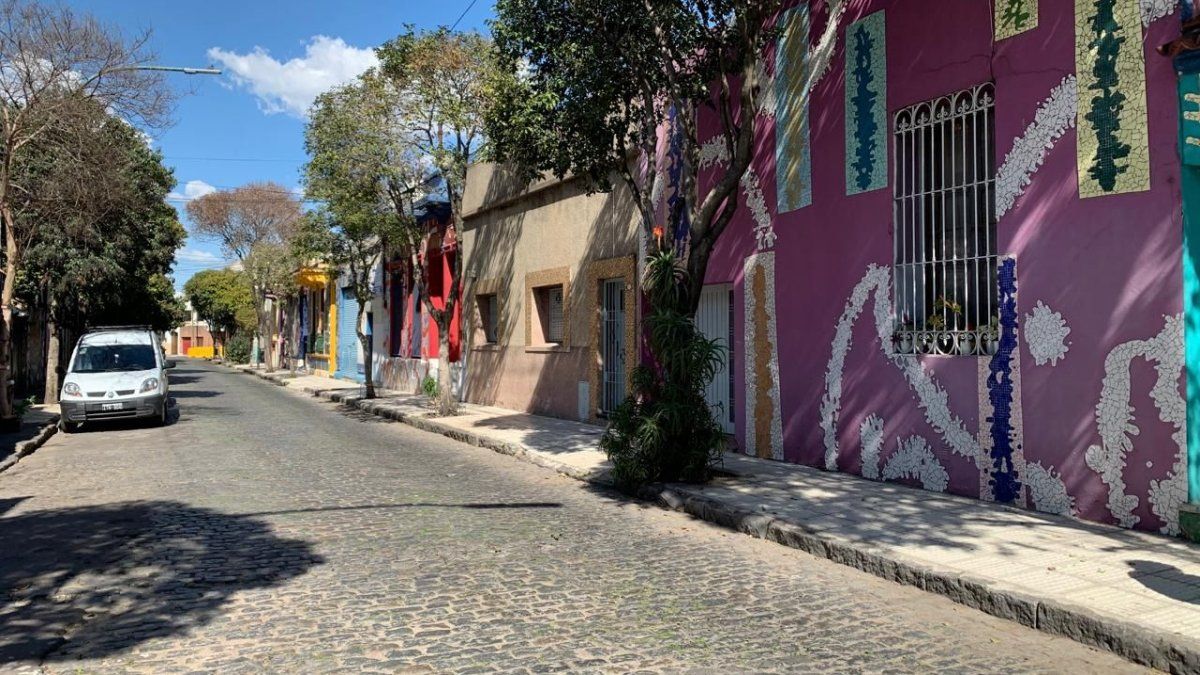
Casas multicolores y fachadas que parecen Caminito: dónde quedan los pasajes del Sur y cuánto vale vivir allí
Transformados en íconos culturales porteños por la intervención del artista Marino Santa María, combinan arte urbano y vida barrial con precios competitivos.
July 15, 2025
Transformed into cultural icons of Buenos Aires by the intervention of artist Marino Santa María, they combine urban art and neighborhood life with competitive prices.
By José Luis Cieri
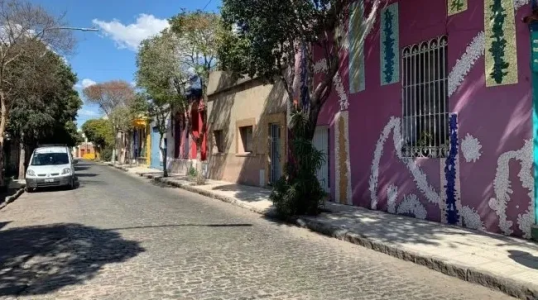
Lanín Passage, the work of artist Marino Santa María provided a result that consolidated the aesthetics of the place with durable materials, light reflections and richer textures.
Art has forever transformed a street in southern Buenos Aires. Pasaje Lanín , in the heart of Barracas , shed its drab outline and became an open-air art gallery. Often compared to Caminito for its tourist appeal, it has established itself as a cultural landmark thanks to the vision and work of artist Marino Santa María . However, the area also remains popular with the real estate market and those looking to live in this part of southern Buenos Aires .
The Lanín Passageway begins at Suárez and Feijoó and curves three blocks to Brandsen, while the Icalma Passageway begins at Feijoó, next to the former Amorrortu publishing house and a cooperative with a cultural complex. Although close to Lanín, Icalma maintains a more residential profile and has only partially received artistic interventions.
The story of this urban intervention begins in the late 1990s. Santa María lived in his home-studio on Lanín and decided to break the boundaries of his paintings to bring art into the public space. In 1998, he presented his neighbors with an unusual project: to intervene on the facades with abstract designs that fused color, geometry, and fragments of his easel works.
With progressive support from the neighborhood, the first phase of painted facades was inaugurated in 2001. The intervention encompassed more than 40 houses and became a unique phenomenon in Buenos Aires. According to the artist, the goal was to democratize art : "I wanted it to leave the galleries and museums and blend into everyday life." Inspired by the Guggenheim Museum in Bilbao, Santa María brought abstract art to a monumental scale to renovate this street in Barracas.
In 2005, the second major transformation took place: Venetian mosaics and trencadís tiles replaced the original paint, which was more vulnerable to weathering. Marino himself drove this change, advised by colleagues and supported by companies in the sector.
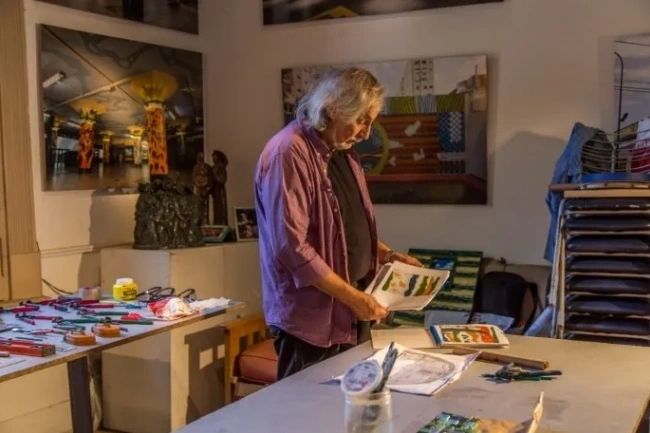
Marino Santa María in action in his workshop located in the area. The materials chosen were the most suitable for public spaces, such as outdoor latex, thanks to the support of a major paint manufacturing company, " provided by my friend and colleague Pérez Celis," he said.
Over the years, the work has received awards and distinctions, including recognition by the Buenos Aires City Legislature as a "Site of Cultural Interest" and "Cultural Heritage of Barracas."
Santa María also incorporated reliefs, improved sidewalks and LED lighting, and ensured this area became part of cultural circuits such as Museum Night and the Design District.
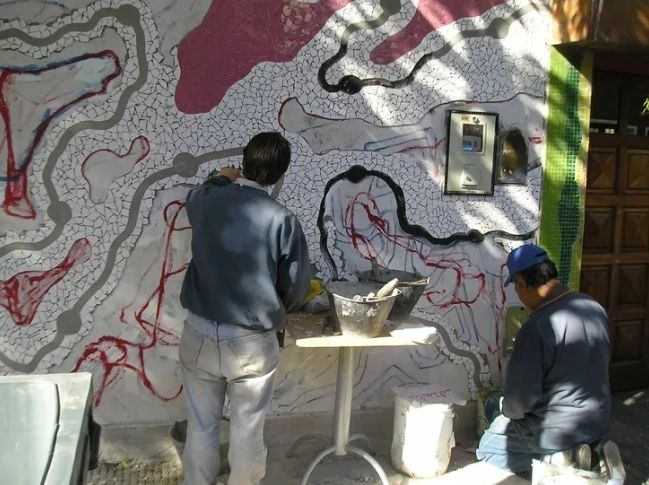
Residents and artists work on the facades of the Lanín Passage with mosaics and bright colors, consolidating its identity as an open-air art gallery.
The artist reflects: "The Lanín Street project was entirely my idea, born from the need to produce a work with a distinct communication. I wanted art to give identity to a neighborhood and be part of daily life. Today it's a symbol of the south of the city."
With camera in hand
Pablo Gabriel Fernández , a specialist in urban planning and historical heritage, famous on social media, frequently visits areas of the city, and the Lanín Passage is no exception. He described its unique atmosphere: "The peace you breathe there is wonderful. The color and warmth of the facades invite you to linger. You can try to photograph it a thousand times, but only in person can you appreciate the details of the mosaics and the changing reflection of the light."
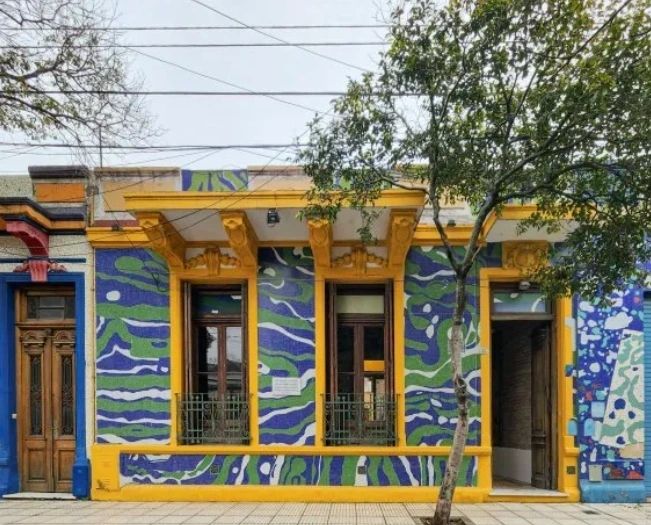
Homes that shine in multicolour
For Fernández, these projects transform not only the aesthetics but also community life. "Pasaje Lanín created a sense of belonging. The neighbors actively participated and today feel proud of their street. It's also a tourist attraction that revitalizes the area without losing the neighborhood spirit," he said.
The success of the Lanín Passageway inspired other nearby projects, such as the Icalma Passageway . Although less well-known, this alleyway shares the tranquil spirit and human scale difficult to find in other areas of Buenos Aires.
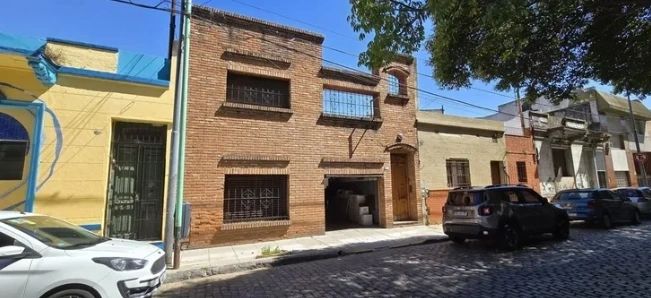
The Icalma Passage has fewer interventions
Fernández added: "There's also a sense of art and community, with the added benefit of being very close to developments like the Barracas Central complex."
Real estate in the south of Buenos Aires
The Barracas real estate market is experiencing a period of consolidation. MKS Properties explained that the neighborhood combines tradition and history with accessibility and renewal. "Connectivity to the city center, proximity to La Boca and San Telmo, and improved infrastructure have made Barracas an increasingly sought-after option," they emphasized.
The firm highlighted the uniqueness of the alleys: "They are true refuges within the city. They offer calm, picturesque aesthetics, and a community atmosphere not found on the main avenues. They are highly valued areas for those seeking something different and steeped in history."
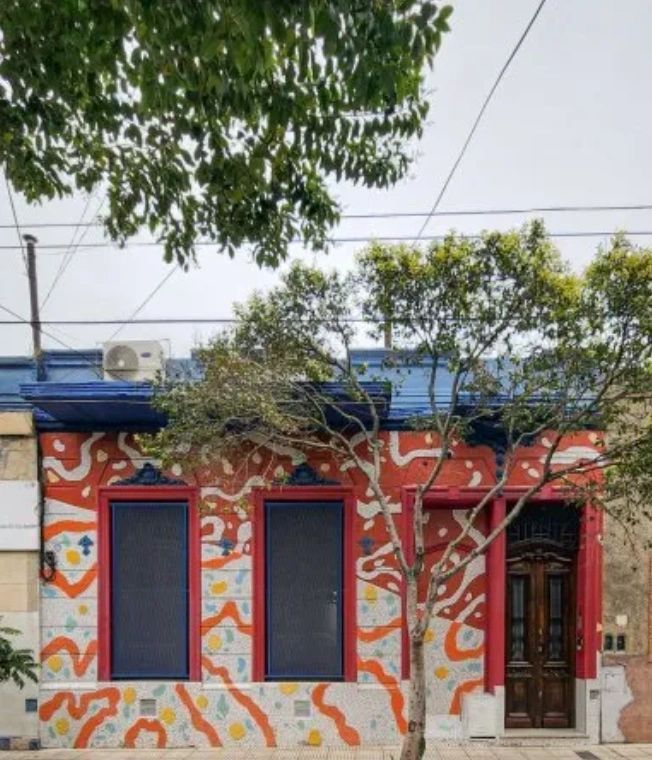
For many, choosing Barracas means choosing a neighborhood with a memory, community, and future. A place where history is evident in every brick and art permeates the sidewalks.
In terms of prices, MKS detailed that in Pasaje Lanín, a one-bedroom apartment typically sells for between $80,000 and $120,000 , while larger homes can exceed $200,000 , depending on the square footage and condition. In Pasaje Icalma, prices are similar, although some properties retain more of the original features, appealing to those who value authenticity. A four-bedroom house with a garage and four bedrooms is currently selling for $183,000.
Clayton Pearse of Prizma Brokers explained that Barracas's appreciation is driven by several factors. "Urban development, infrastructure improvements, and residential expansion are driving prices. There's real interest from young families and professionals looking for affordable neighborhoods with history and good connectivity. Policies such as mortgage lending and money laundering also play a role, boosting the market," he commented.
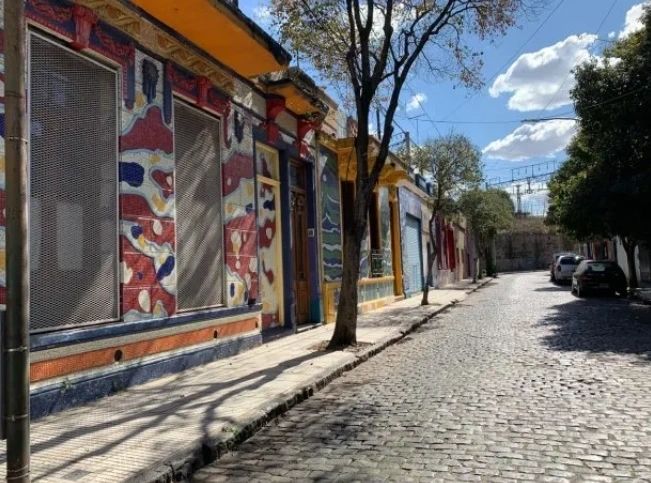
Cobblestone streets are also part of the ecosystem of this place.
Pearse emphasized the unique value of the Lanín and Icalma passages: "The open-air art, the intervention of the artist Santa María, and the passage's character offer a unique heritage value. It's not just about buying square meters; it's about buying identity, history, and a distinct experience of the city. Furthermore, the proximity to Barracas Central adds to the city's presence, because this development creates a center of attraction and services that enhances the entire area."
The Barracas Central building is one of the key drivers of change in the area. Built on the site of the historic Piccaluga & Cia. spinning mill, the project restored original facades and materials to transform it into a complex of lofts, studios, and modern amenities.
Local inhabitants
Marisa Paula Martínez , a resident of the neighborhood and the complex, said: "Pasaje Lanín is a postcard of the neighborhood, quiet, with neighbors greeting each other and enjoying a barbecue on Sundays. Marino Santa María walks around like everyone else and chats with everyone. His artistic interventions add warmth and color to the area. Living near the passageway is knowing that you have art on the sidewalk."
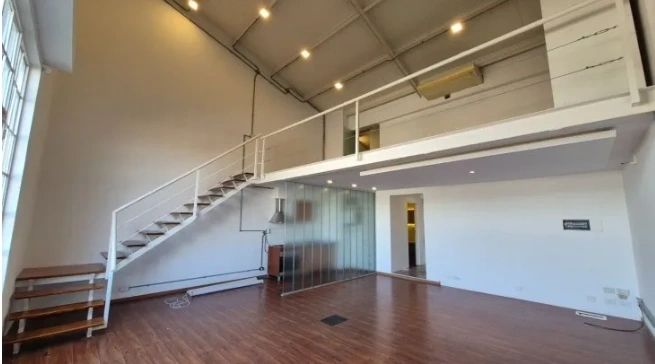
One of the lofts for sale there (Photo Courtesy: Molinero Properties).
Regarding her experience living in a loft in Barracas Central, she described: "The spaciousness was key for me. I came from a chorizo-style house with a garden, and here I have a practical, stripped-down space, with the freedom to change the layout. Plus, the building preserves its history: it was a textile factory that rescued its robust essence and was converted into modern housing. It has internal streets, a green terrace, and a Zen park. It's like a mini-neighborhood inside the building, with nature and fresh air."
Marianela Brovelli , an interior designer and also a resident of the neighborhood, agreed on the value of art and history: "Pasaje Lanín is a unique place. Marino worked on it 25 years ago and managed to capture everyone's attention. Today it belongs to the Design District and is part of the city's cultural circuit. It's common to see tourists on bikes or on foot, especially at events like Museum Night. Walking through Lanín and Icalma is like seeing how art has changed the face of the neighborhood."
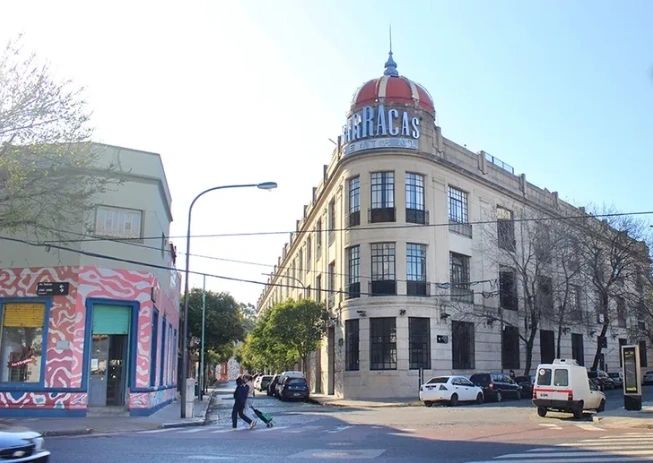
The historic Piccaluga & Cia spinning mill was converted into a project with a loft and offices in Pasaje Lanín, Feijoo and near Avenida Suárez.
Regarding loft living, Brovelli commented: "It's a disruptive and relaxed space. Although it's not very large, it feels spacious because the ceilings are high and the rooms are integrated. Furthermore, Barracas Central is a unique complex: it recycled a historic building and added a garden, pool, sauna, and gym. It has convenient access and is close to the highway and neighborhoods with a lively cultural scene. It's like living in an oasis within the city."

There are comfortable and stylishly decorated homes.
Both neighbors emphasized the project's social role. "Pasaje Lanín not only changed the aesthetics, it also strengthened the community. It's a place where everyone participates, where there is identity. It's part of Barracas' pride," they affirmed.
The subway will be key
Regarding the market, MKS and Pearse agreed that the area offers varied opportunities. Lanín and Icalma streets feature low-rise homes with patios, terraces, and artfully decorated facades, with competitive prices compared to more expensive areas of the city. A two-bedroom rental there ranges from $650,000.
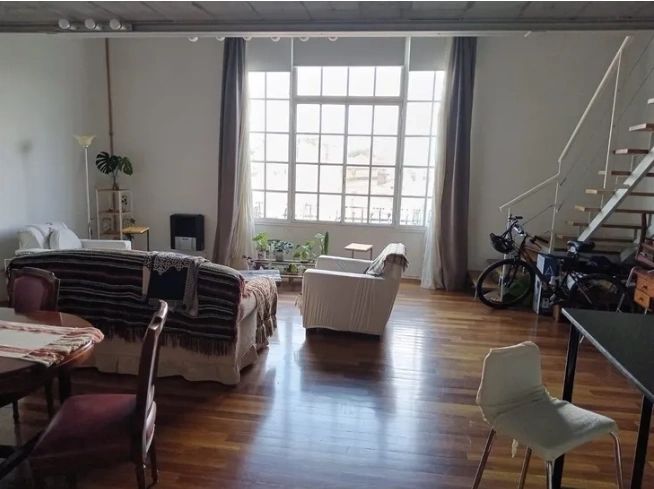
With units averaging 80 m2 and well-maintained interiors.
Barracas's rise is partly explained by its strategic location. Minutes from downtown, with direct access to the 9 de Julio Sur Highway (AU1) and connectivity to La Boca, San Telmo, and Puerto Madero, the neighborhood combines tradition and presence.
A key factor is the future subway Line F , which will connect Barracas with Palermo over a 9-kilometer stretch with 11 stations. The first phase will include stops such as Brandsen and Constitución, which will improve connections with the rest of Buenos Aires and boost its residential development.
www.buysellba.com

